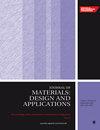Three-dimensional printed silk fibroin and fenugreek based bio-composites scaffolds
IF 2.2
4区 材料科学
Q3 MATERIALS SCIENCE, MULTIDISCIPLINARY
Proceedings of the Institution of Mechanical Engineers, Part L: Journal of Materials: Design and Applications
Pub Date : 2024-03-25
DOI:10.1177/14644207241241156
引用次数: 0
Abstract
When treating orthopaedic damage or illness and accidental fracture, bone grafting remains the gold standard of treatment. In cases where this approach doesn't seem achievable, bone tissue engineering can offer scaffolding as a substitute. Defective and fractured bone tissue is extracted and substituted with porous scaffold structures to aid in the process of tissue regeneration. Three-dimensional bioprinting has demonstrated enormous promise in recent years for producing scaffold structures with the necessary capabilities. In order to create composite biomaterial inks for three-dimensional bioprinting, four different materials were combined such as silk fibroin, bone particles (B), synthetic biopolymer poly (ε-caprolactone), and Fenugreek (F). These biomaterials were mixed together in certain proportion to develop a silk fibroin + bovine bone + polycaprolactone + fenugreek powder composites biomaterial which was later three-dimensional bioprinted to fabricated composite bio-scaffold. The biomechanical, structural, and biological elements of the manufactured composite scaffolds were characterized in order to determine their suitability as a possible biomaterial for the production of bone tissue. The in vitro bioactivity of the composite scaffolds was assessed in the simulated body fluids, and the swelling and degradation characteristics of the two developed scaffolds were analyzed separately over time. The results showed that the mechanical durability of the composite scaffolds was enhanced by the bovine bone particles, up to a specific concentration in the silk fibroin matrix. Furthermore, the incorporation of bone particles improved the bioactive composite scaffolds’ capacity to generate hydroxyapatite in vitro. The combined findings show that the three-dimensional printed bio-composites scaffolds have the required mechanical strength and may be applied to regeneration of bone tissue and restoration, since they resemble the characteristics of native bone.基于丝纤维素和葫芦巴的三维打印生物复合材料支架
在治疗骨科损伤或疾病以及意外骨折时,骨移植仍然是治疗的黄金标准。在这种方法似乎无法实现的情况下,骨组织工程可以提供支架作为替代。提取缺损和断裂的骨组织,用多孔支架结构替代,帮助组织再生。近年来,三维生物打印技术在生产具有必要功能的支架结构方面展现出巨大前景。为了制造用于三维生物打印的复合生物材料墨水,我们将四种不同的材料结合在一起,如丝纤维素、骨颗粒(B)、合成生物聚合物聚(ε-己内酯)和葫芦巴(F)。将这些生物材料按一定比例混合,制成蚕丝纤维素+牛骨+聚己内酯+葫芦巴粉复合生物材料,然后进行三维生物打印,制成复合生物支架。对制造的复合支架的生物力学、结构和生物要素进行了表征,以确定其是否适合作为生产骨组织的生物材料。在模拟体液中对复合材料支架的体外生物活性进行了评估,并分别分析了两种支架随时间变化的膨胀和降解特性。结果表明,复合支架的机械耐久性在蚕丝纤维素基质中达到特定浓度时会因牛骨颗粒而增强。此外,骨颗粒的加入还提高了生物活性复合材料支架在体外生成羟基磷灰石的能力。综合研究结果表明,三维打印生物复合材料支架具有所需的机械强度,可用于骨组织的再生和修复,因为它们与本地骨的特性相似。
本文章由计算机程序翻译,如有差异,请以英文原文为准。
求助全文
约1分钟内获得全文
求助全文
来源期刊

CiteScore
4.70
自引率
8.30%
发文量
166
审稿时长
3 months
期刊介绍:
The Journal of Materials: Design and Applications covers the usage and design of materials for application in an engineering context. The materials covered include metals, ceramics, and composites, as well as engineering polymers.
"The Journal of Materials Design and Applications is dedicated to publishing papers of the highest quality, in a timely fashion, covering a variety of important areas in materials technology. The Journal''s publishers have a wealth of publishing expertise and ensure that authors are given exemplary service. Every attention is given to publishing the papers as quickly as possible. The Journal has an excellent international reputation, with a corresponding international Editorial Board from a large number of different materials areas and disciplines advising the Editor." Professor Bill Banks - University of Strathclyde, UK
This journal is a member of the Committee on Publication Ethics (COPE).
 求助内容:
求助内容: 应助结果提醒方式:
应助结果提醒方式:


